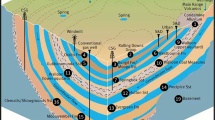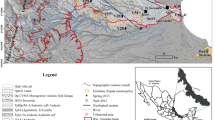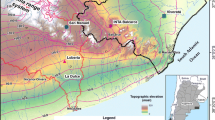Abstract
High-resolution one-dimensional profiles of naturally occurring environmental tracers (3H, δD, δ18O, 14C-DIC, 14C-DOC, 36Cl, 4He, and major ions) and hydraulic data were used to study residence times, transport mechanisms, and sources of pore water and solutes in an aquitard system in Saskatchewan, Canada. The aquitard system consisted of 80 m of plastic clay-rich Battleford till discomformably overlying 77 m of Late Cretaceous plastic marine clay. Individual tracers independently revealed molecular diffusion as the dominant transport mechanism in the unoxidized nonfractured till and clay. Transport modeling indicated that late Pleistocene-age pore water at 35–55 m below ground was emplaced 15–30 thousand years Before Present (ka BP) during till deposition and ice retreat. The late Holocene climatic transition was estimated to have occurred 7–12 ka BP. Differences in the timing of events determined with different tracers were attributed to inaccuracies in transport parameters and boundary condition assumptions. This study showed that solute transport in clay-rich aquitards can be accurately predicted for time scales beyond 20 ka, and proved such aquitards are suitable for long-term isolation of most wastes.
Résumé
Des profils haute résolution unidimentionnels avec traceurs environnementaux naturels (3H, δD, δ18O, 14C-DIC, 14C-DOC, 36Cl, 4He, et ions majeurs) et des données hydrauliques ont été utilisés pour étudier les temps de séjour, le mécanismes de transfert et l’origine de l’eau et des solutés inclus dans les pores d’un système aquitard du Saskatchewan, Canada. L’aquitard est constitué par 80 m de tillite de Battleford riche en argile plastique, discordante sur 77 m d’argile plastique marine du Crétacé supérieur. Les traceurs indiquent chacun la diffusion moléculaire comme moyen de transport dominant dans l’argile non fracturée et non oxydée de la tillite. La modélisation du transport indique que l’eau est contemporaine du dépôt des tillites à 35–55 m de profondeur durant retrait des glaciers au Pléistocène supérieur il y a 15 à 30 ka. On estime que la transition holocène tardive s’est déroulée il y a 7 à 12 ka. Les différences dans la chronologie des évènements établie avec les traceurs ont été attribuées à des imprécisions liées aux paramètres de migration et hypothèses sur les conditions aux limites. Cette étude a montré que le transport de solutés dans des aquitards riches en argile peut être prévu avec précision pour des échelles de temps au-delà de 20 ka, prouvant que de tels aquitards conviennent pour le confinement à long terme de la plupart des déchets.
Resumen
Se usaron perfiles unidimensionales de alta resolución de trazadores ambientales que naturalmente existen (3H, δD, δ18O, 14C-DIC, 14C -DOC, 36Cl, 4He, y iones mayoritarios) y datos hidráulicos, para estudiar los tiempos de residencia, mecanismos de transporte y fuentes de agua poral y solutos en un sistema acuitardo en Saskatchewan, Canada. El sistema acuitardo consistía en 80 m del till Battleford plástico rico en arcilla que yace discordantemente sobre 77 m de arcilla plástica marina del Cretácico Tardío. Independientemente los trazadores individuales revelaron a la difusión molecular como un mecanismo de transporte dominante en el till no fracturado y no oxidado y en la arcilla. El modelado del transporte indicó que el agua poral de edad Pleistocena tardía en los 35–55 m debajo del terreno se instaló 15–30 mil años antes del presente (ka AP) durante la depositación del till y la retracción del hielo. Se estima que la transición climática del Holoceno tardío ocurrió 7–12 ka AP. Las diferencias en los tiempos de estos eventos determinados con diferentes trazadores se atribuyeron a inexactitudes en los parámetros de transporte y en las supuestas condiciones de contorno. Este estudio mostró que el transporte de soluto en acuitardos ricos en arcillas pueden ser predichos con precisión para escalas de tiempo más allá de 20 ka, y probó que tales acuitardos son apropiados para el aislamiento a largo plazo de la mayoría de los residuos.
摘要
本文用环境示踪剂 (δ3H, δD, δ18O, 14C-DIC, 14C-DOC, 36Cl, 4He和主要离子) 和水文资料的高分辨率一维剖面, 研究位于加拿大Saskatchewan省某隔水层系统的地下水驻留时间, 运移机制以及孔隙水和溶质的来源. 该弱透水层系统由80m厚塑性富粘土的Battleford 冰碛物组成, 下伏77m厚上白垩系塑性海相粘土, 二者为不整合接触. 各示踪剂单独揭示, 在未氧化和无裂隙冰碛物和粘土中, 水的主要运移机制为分子扩散. 运移模型表明, 地下35–55m处的晚更新世孔隙水为冰川退缩和漂砾沉积期 (15–30 ka BP) 形成. 全新世的气候转变期应为7–12 ka BP. 不同示踪剂定出的年龄有所差异, 其原因为运移参数和边界条件假设的不确定性. 本研究表明, 在大于20 ka的尺度上, 可以准确预测厚层粘土弱透水层中的溶质运移, 证明这类弱透水层适于大多数废物的长期隔离.
Resumo
Perfis unidimensionais de alta resolução usando traçadores que ocorrem naturalmente no ambiente [3H, δD, δ18O, 14C-CID (Carbono Inorgânico Dissolvido), 14C –COD (Carbono Orgânico Dissolvido), 36Cl, 4He, e iões principais] e dados hidráulicos foram usados para o estudo dos tempos de residência, dos mecanismos de transporte, e das origens da água dos poros e dos solutos num sistema aquitardo em Saskatchewan, no Canadá. O sistema aquitardo consiste em 80 m de sedimentos glaciares (till) de Battleford, ricos em argila plástica, sobrepondo em desconformidade 77 m de argila plástica de origem marinha do Cretácico superior. Traçadores individuais revelaram, de modo independente, a difusão molecular como o mecanismo de transporte dominante na argila e no till não fracturados e não oxidados. A modelação de transporte indicou que a água localizada nos poros entre os 35 e os 55 m é do Plistocénico superior, e terá infiltrado há cerca de 15–30 mil anos atrás, durante a deposição do till e o recuo do gelo. Estima-se que a transição climática do Holocénico superior terá ocorrido há 7–12 mil anos atrás. As diferenças na calendarização dos eventos, determinadas por diferentes traçadores, foram atribuídas a inexactidões nos parâmetros de transporte e nas assumpções das condições de fronteira. Este estudo mostrou que o transporte de solutos nos aquitardos ricos em argila pode ser previsto com precisão para escalas de tempo com mais de 20 mil anos, e provou que estes aquitardos são apropriados para o isolamento, a longo prazo, da maioria dos resíduos.







Similar content being viewed by others
References
Bard E, Arnold M, Fairbanks RG, Hamelin B (1993) 230Th-234U and 14C ages obtained by mass spectrometry on corals. Radiocarbon 35:191–199
Bentley HW, Phillips FM, Davis SN (1986) Chlorine-36 in the terrestrial environment. In: Fritz P, Fontes JC (eds) Handbook of environmental isotope geochemistry. Elsevier, Amsterdam, pp 427–480
Birks SJ, Remenda VH, Edwards TWD (2000) Clay aquitards and isotopic archives of Holocene palaeoclimate in the Northern Great Plains: sensitivity analysis. Hydrol Process 14:1523–1536
Boldt-Leppin BEJ, Hendry MJ (2003) Application of harmonic analysis of water levels to determine the vertical hydraulic conductivities of clay-rich aquitards. Ground Water 41(4):514–522
Bottomley DJ, Ross JD, Clarke WB (1984) Helium and neon isotope geochemistry of some ground waters from the Canadian Precambrian Shield. Geochim Cosmochim Acta 48(10):1973–1985
Castro MC, Goblet P (2003) Noble gas thermometry and hydrologic ages: evidence for late Holocene warming in southwest Texas. Geophys Res Lett 30(24):2251. doi:10.1029/2003GL018875
Castro MC, Stute M, Schlosser P (2000) Comparison of He-4 ages and C-14 ages in simple aquifer systems: implications for groundwater flow and chronologies. Appl Geochem 15(8):1137–1167
Cey BD, Barbour SL, Hendry MJ (2001) Osmotic flow through a Cretaceous clay in southern Saskatchewan, Canada. Can Geotech J 38(5):1025–1033
Christiansen EA (1971) Tills in southern Saskatchewan, Canada. In: Goldthwait RP (ed) Till: a symposium. The Ohio State University Press, Columbus, OH, pp 167–183
Christiansen EA (1986) Geology of Luck Lake IrrigationProject. Report 0114-002, Saskatchewan Water Corporation, Moose Jaw, SK
Christiansen EA (1992) Pleistocene stratigraphy of the Saskatoon area, Saskatchewan, Canada: an update. Can J Earth Sci 29(8):1767–1778
Desaulniers DE, Cherry JA (1989) Origin and movement of groundwater and major ions in a thick deposit of Champlain Sea clay near Montreal. Can Geotech J 26(1):80–89
Desaulniers DE, Cherry JA, Fritz P (1981) Origin, age and movement of pore water in argillaceous Quaternary deposits at four sites in southwestern Ontario. J Hydrol 50:231–257
Desaulniers DE, Kaufmann RS, Cherry JA, Bentley HW (1986) 37Cl–35Cl variations in a diffusion-controlled groundwater system. Geochim Cosmochim Acta 50(8):1757–1764
Harrington GA, Hendry MJ (2005) Chemical heterogeneity in diffusion-dominated aquitards. Water Resour Res 41(12), W12432
Harrington GA, Hendry MJ, Robinson NI (2007) Impact of permeable conduits on solute transport in aquitards: mathematical models and their application. Water Resour Res 43, W05441
Hazen A (1892) Some physical properties of sand and gravels. In: Annual report, Massachusetts State Board of Health, Boston, MA, pp 539–556
Hendry MJ, Wassenaar LI (1999) Implications of the distribution of δD in pore waters for groundwater flow and the timing of geologic events in a thick aquitard system. Water Resour Res 35(6):1751–1760
Hendry MJ, Wassenaar LI (2000) Controls on the distribution of major ions in pore waters of a thick surficial aquitard. Water Resour Res 36(2):503–513
Hendry MJ, Wassenaar LI (2005) Origin and migration of dissolved organic carbon fractions in a clay-rich aquitard: 14C and δ13C evidence. Water Resour Res 41(2), W02021
Hendry MJ, Wassenaar LI (2009) Inferring heterogeneity in aquitards using high resolution δD and δ18O profiles. Ground Water 47(5):639–645
Hendry MJ, Woodbury AD (2007) Clay aquitards as archives of Holocene paleoclimate: δ18O and thermal profiling. Ground Water 45(6):683–691
Hendry MJ, Cherry JA, Wallick EI (1986) Origin and distribution of sulfate in a fractured till in southern Alberta, Canada. Water Resour Res 22(1):45–61
Hendry MJ, Wassenaar LI, Kotzer T (2000) Chloride and chlorine isotopes (36Cl and δ37Cl) as tracers of solute migration in a thick, clay-rich aquitard system. Water Resour Res 36(1):285–296
Hendry MJ, Ranville JR, Boldt-Leppin BEJ, Wassenaar LI (2003) Geochemical and transport properties of dissolved organic carbon in a clay-rich aquitard. Water Resour Res 39(7):1194. doi:10.1029/2002WR001943
Hendry MJ, Kotzer TG, Solomon DK (2005) Sources of radiogenic helium in a clay till aquitard and its use to evaluate the timing of geologic events. Geochim Cosmochim Acta 69(2):475–483
Hendry MJ, Barbour SL, Boldt-Leppin BEJ, Reifferscheid LJ, Wassenaar LI (2009) A comparison of laboratory and field based determinations of molecular diffusion coefficients in a low permeability geologic medium. Environ Sci Technol 43(17):6730–6736
Hvorslev MJ (1951) Time lag and soil permeability in ground-water observations. Bull. no. 36, US Army Corps, Vicksburg, MI, pp 1–50
Ivanovich M, Frohlich K, Hendry MJ (ed) (1991) Dating very old groundwater, Milk River Aquifer, Alberta, Canada. Appl Geochem (Spec. Issue) 6(4):367–472
Keller CK, van der Kamp G, Cherry JA (1989) A multiscale study of the permeability of a thick clayey till. Water Resour Res 25(11):2299–2317
Koehler G, Wassenaar LI, Hendry MJ (2000) An automated technique for measuring δD and δ18O values of porewater by direct CO2- and H2- equilibration. Anal Chem 72(22):5659–5664
Kotzer T, Gascoyne M, Mukai M, Ross J, Waito G, Milton G, Cornett RJ (1998) 36Cl, 129I and noble gas isotope systematics in groundwaters from the Lac du Bonnet Batholith, Manitoba, Canada. Radiochim Acta 82:313–318
Kulongoski JT, Hilton DR, Cresswell RG, Hostetter S, Jacobson G (2008) Helium-4 characteristics of groundwaters from Central Australia: comparative chronology with chlorine-36 and carbon-14 dating techniques. J Hydrol 348(1–2):176–194
Lawrence JR, Hendry MJ, Wassenaar LI, Germida JJ, Wolfaardt GM, Fortin N, Greer CW (2000) Distribution and biogeochemical importance of bacterial populations in a thick clay-rich aquitard system. Microbial Ecol 40:273–291
Love AJ, Herczeg AL, Sampson L, Cresswell RG, Fifield LK (2000) Sources of chloride and implications for Cl-36 dating of old groundwater, southwestern Great Artesian Basin, Australia. Water Resour Res 36(6):1561–1574
Marine IW (1979) The use of naturally occurring helium to estimate ground water velocities for studies of geologic storage of radioactive waste. Water Resour Res 15:1130–1136
Pearson FJ (1999) What is the porosity of a mudrock? From: Muds and mudstones: physical and fluid flow properties. In: Aplin AC, Fleet AJ, MacQuaker JHS (eds) Geol Soc Lond Spec Publ 158:9–21
Remenda VH, van der Kamp G, Cherry JA (1996) Use of vertical profiles of δ18O to constrain estimates of hydraulic conductivity in a thick, unfractured aquitard. Water Resour Res 32(10):2979–2987
Reszat TN, Hendry MJ (2009) Migration of colloids through nonfractured clay-rich aquitards. Environ Sci Technol 43(15):5640–5646
Sauchyn DJ (1990) A reconstruction of Holocene geomorphology and climate, western Cypress Hills, Alberta and Saskatchewan. Can J Earth Sci 27(11):1504–1510
Shaw RJ, Hendry MJ (1998) Hydrogeology of a thick clay till and Cretaceous clay sequence, Saskatchewan, Canada. Can Geotech J 35(6):1041–1052
Sheldon AL, Solomon DK, Poreda RJ, Hunt A (2003) Radiogenic helium in shallow groundwater within a clay till, southwestern Ontario. Water Resour Res 39(12):1331. doi:10.1029/2002WR001797
Simpkins WW, Bradbury KR (1992) Groundwater flow, velocity, and age in a thick, fine-grained till unit in southeastern Wisconsin. J Hydrol 132:283–319
Solomon DK (2000) 4He in Groundwater. In: Cook PG, Herczeg AL (eds) Environmental tracers in subsurface hydrology. Kluwer, Boston, pp 425–439
Timms WA, Hendry MJ (2006) Quantifying the impact of cation exchange on long-term solute transport in a clay-rich aquitard. J Hydrol 332(1–2):110–122
van der Kamp G, Van Stempvoort DR, Wassenaar LI (1996) The radial diffusion method: 1. using intact cores to determine isotopic composition, chemistry, and effective porosities for groundwater in aquitards. Water Resour Res 32(6):1815–1822
van Stempvoort D, Hendry MJ, Schoenau JJ, Krause HR (1994) Sources and dynamics of sulfur in weathered till, western glaciated plains of North America. Chem Geol 111(1–4):35–56
Vengosh A, Hendry MJ (2001) Chloride-bromide-δ11B systematics of a thick clay-rich aquitard system. Water Resour Res 37(5):1437–1444
Wassenaar LI, Hendry MJ (1999) Improved piezometer construction and sampling techniques to determine pore water chemistry in aquitards. Ground Water 37(4):564–571
Wassenaar LI, Hendry MJ (2000) Mechanisms controlling the distribution and transport of 14C in a clay-rich till aquitard. Ground Water 38(3):343–349
Wassenaar LI, Hendry MJ, Aravena R, Fritz P (1990) Organic carbon isotope geochemistry of clayey deposits and their associated porewaters, southern Alberta. J Hydrol 120(1–4):251–270
Wassenaar L, Aravena R, Hendry J, Fritz P (1991) Radiocarbon in dissolved organic carbon: a possible groundwater dating method—case studies from western Canada. Water Resour Res 27(8):1975–1986
Wassenaar LI, Hendry MJ, Chostner VL, Lis GP (2008) High resolution pore water δ2H and δ18O measurements by H2O(liquid)–H2O(vapor) equilibration laser spectroscopy. Environ Sci Technol 42(24):9262–9267
Youngman MJ (1989) Dissolved gases and radioelements in groundwaters. PhD Thesis, University of Bath, UK, 422 pp
Acknowledgements
Long-term financial support was provided by the Natural Sciences and Engineering Research Council of Canada and Cameco Co. Ltd. through the NSERC-Cameco Research Chair, the Saskatchewan Potash Producers Association, and Environment Canada. The assistance of many collaborators and students who contributed to the papers upon which this one was based is gratefully acknowledged.
Author information
Authors and Affiliations
Corresponding author
Rights and permissions
About this article
Cite this article
Hendry, M.J., Wassenaar, L.I. Millennial-scale diffusive migration of solutes in thick clay-rich aquitards: evidence from multiple environmental tracers. Hydrogeol J 19, 259–270 (2011). https://doi.org/10.1007/s10040-010-0647-4
Received:
Accepted:
Published:
Issue Date:
DOI: https://doi.org/10.1007/s10040-010-0647-4




